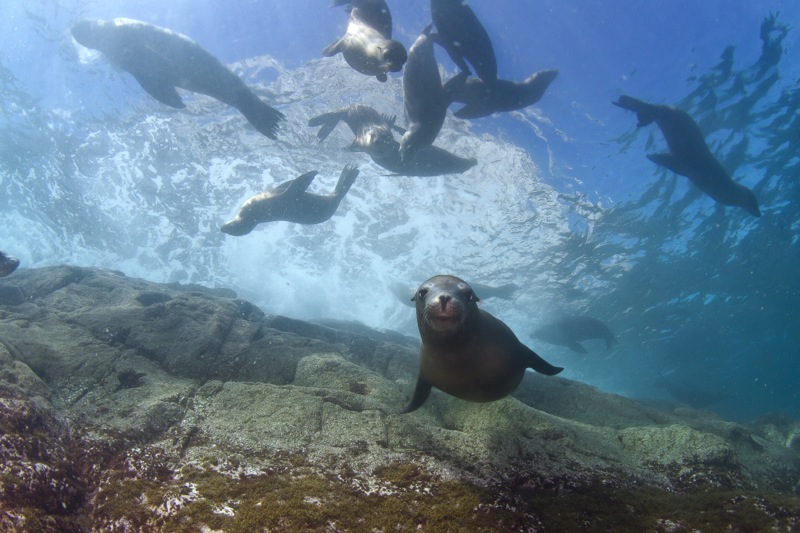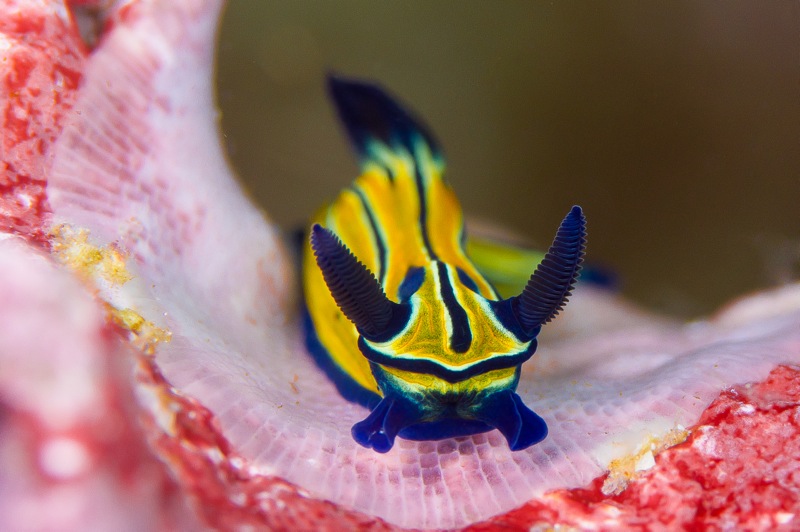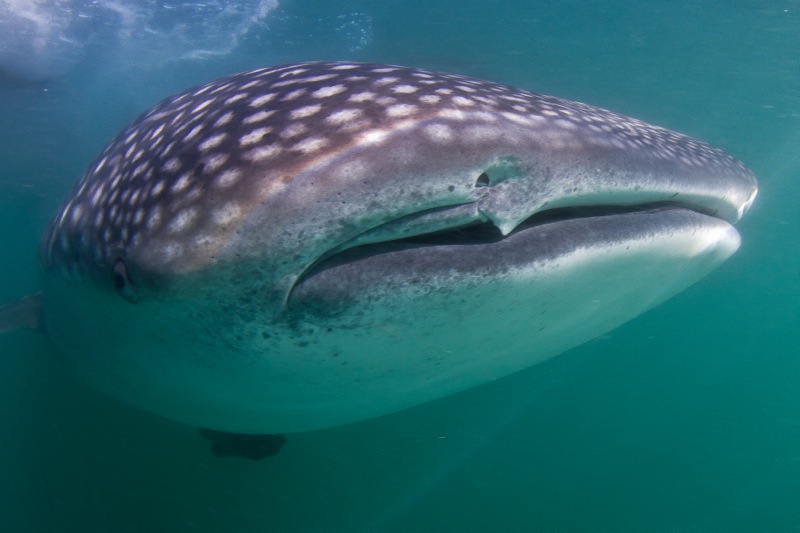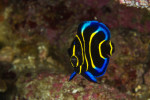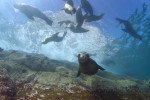I ran to the outside of the ship, thinking that the Captain had cut the engines to signal that the sperm whales we were “hunting” were close. I looked out at the cresting grey backs. A pod of pilot whales circled the boat with loud, playful breaths audible even above the “oohs” and “ahhs” from the other divers perched on the rails. These were not the sperm whales we had been seeking. But this is what my week-long trip on the Rocio del Mar was like . . . full of unexpected wonder.
———————————————————
Words and photos by Todd Aki
———————————————————
Dora and her husband, Lolo, built the Rocio Del Mar (RDM) three years ago. They designed it specifically for divers. The all-steel ship is 110 feet long. Two inflatables take divers to sites a few minutes from the “mother” ship. To stabilize the ship in rough seas, an outrigger on each side of the boat is attached by metal chains to a large, flat, triangular metal piece fifteen feet underwater, which helps dampen the ship’s movement. The ship has ten cabins—each with a private bathroom and shower.
The RDM dives the Midriff Islands in the northern Sea of Cortez and is the only liveaboard in the area. For California divers, it is a short flight to Phoenix, Arizona, where you catch an air-conditioned shuttle and travel three-and-a-half hours south to the boat, which is docked in Puerto Peñasco. That night, the southward journey begins, and in the morning, it is time to dive. A typical day on the RDM begins with a self-serve continental breakfast, followed by the first dive. After a hot breakfast, it’s back in the water for the second dive, and then lunch. Two more dives, then it’s time for dinner. There are also two night dives during the week. While the divers sleep, the ship travels south to San Pedro Martir, before looping around and heading back north to Puerto Peñasco.
Weather in the Sea of Cortez can change quickly. These changing conditions, along with the twenty-foot tidal change, can cause tricky sea conditions, so it is nice to have Lolo as the Captain. He has fished these areas for years, and his knowledge of where to hide out from bad weather is a huge asset. On our trip, we had two days of very high winds. Although the weather prevented us from diving some of the premier dive locations, Lolo kept us safe and took us to calmer areas to dive.
Creatures great and small
What struck me the most about diving in the Midriff Islands was the variety of sea life. On our trip, we saw sperm whales, pilot whales, fin whales, huge pods of dolphins, and the largest fish in the ocean—the whale shark. We also saw many different species of nudibranchs. The reef fish, which included a variety of rays, eels, and octopi, were abundant and colorful. Although we didn’t see any, Humboldt squid are often spotted here. In fact, Dora recently had a cage built with plexiglass sides to allow divers to safely get in the water with this sometimes-aggressive squid.
While motoring through the multitude of small islands, we reveled in the breathtaking topside views. The islands have shear walls with striking shades of brown, often dotted with different species of cacti. Lava tubes are visible above and below the ocean level. Unusually shaped pinnacles rise from the water. They look as though they are covered with snow, but the “snow” is actually guano.
The Sea of Cortez is home to one of the largest colonies of sea lions, and on many dives, they come out to play with the divers. The sea lions are very curious about divers, often swimming very close to investigate. They seem to enjoy imitating the divers’ behavior; if a diver spins around, the sea lion often copies his movements. However, on one dive, a few sea lions got a little too playful with me. At first, they started swimming rapidly towards me, veering off at the last second. When this became boring for them, one snuck up behind me and bit, or kissed, the top of my head. But when they started to nibble my camera gear, it was the final straw. I had to call the dive.
Rare, memorable encounters
We spent the last day in a bay known for whale shark sightings. After being unlucky with underwater encounters with the sperm and pilot whales, I did not want to get my hopes up. A local villager took groups of four snorkelers at a time out on his panga. After fifteen minutes of searching, he found us a juvenile whale shark. We got in the water and as soon as we saw the whale shark, it quickly swam away. After getting back into the panga, the guide told us that the day before, some biologist had tagged the whale sharks, causing them to be more skittish than normal. Our second encounter lasted a bit longer and came none too soon—time was running out. This time, we found a larger whale shark. Jackpot! The whale shark seemed to be just as curious about us as we were about it. Sadly, after thirty minutes, our time was up, and we had to get back into the boat. If I could have, I think I’d still be swimming with my new friend. It was the perfect way to end a wonderful week.
Diving the Midriff Islands on the RDM has many advantages: It is a short trip from California. The ship is very comfortable, the crew is friendly, hard-working, and provides outstanding customer service. Dora, both divemaster and hostess, has a contagious passion for the area, as well as for diving in general. Lastly, the water temperature is comfortable—ranging from 75˚F to 85 ˚F, depending on the time of the year.
Because of the possibility of strong currents and rapidly changing conditions, the area is best suited for experienced divers. The visibility can often drop to twenty feet or less, making wide-angle photography challenging. The water is often green, not blue. But, the Midriff Islands are a great destination, with many undiscovered areas. Divers with a sense of adventure will thoroughly enjoy this trip.
——————————————————————————————————————
Words and photos by Todd Aki
All content ©2013 and may not be used in any way without express written permission
——————————————————————————————————————

